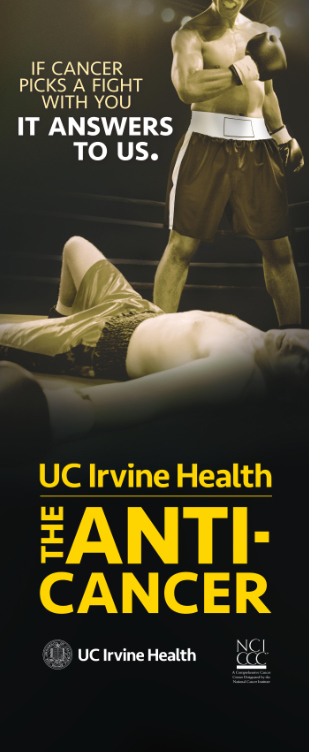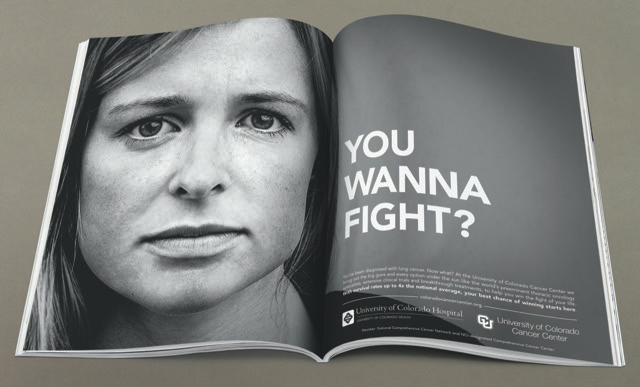Expressions of Rage? Or Inspirational Pep Talks? Whatever You Call Them, Hospital Ads with an Aggressive Stance Could Make Your Market Sit Up and Take Notice
Notable Health Care Advertising
// By Peter Hochstein //
 Fighting words and images may be just the thing some hospitals need to break through the miasma of inattention.
Fighting words and images may be just the thing some hospitals need to break through the miasma of inattention.
In an upcoming issue of this publication, a fellow contributor, James A. Gardner, will write about a campaign for the Canadian pediatric hospital, Sick Kids. The campaign notably uses angry-sounding rap music, images of kids smearing warpaint on their faces, and a variety of adult combat scenes to rail against childhood afflictions. These range from cystic fibrosis, to autism, to cancer.
Twenty-five years ago, this kind of hospital advertising might have been perceived as teetering on the edge of bizarreness. Today, it instead seems to be part of a trend. Among ad campaigns that use testimonials, or humor, or straightforward capabilities-and-outcomes-based presentations, make room for a new category. But what to name it?
A Trend in Search of a Name

Brad Fixler, vice president of marketing at University of Colorado Health
My immediate instinct was to call it “rage-based advertising,” perhaps because its attitude brings to my mind the 1947 Dylan Thomas poem that begins: “Do not go gentle into that good night…Rage, rage against the dying of the light.”
But others, like Brad Fixler, vice president of marketing at the University of Colorado Health, insist it’s not rage, but something else. UCHealth’s University of Colorado Hospital ran a campaign in 2014 and 2015 that took a somewhat similar aggressive stance.

Aggression depicted: In 2014 University of California Irvine Health used ads like these to tell patients it could help them beat cancer.
The Colorado hospital advertising is about hope, not rage, Fixler says. He insists it’s more like the pep talk that Al Pacino gives the team he’s coaching in the football movie On Any Given Sunday. To loosely paraphrase Fixler, it’s a call to take advantage of the teamwork and considerable medical resources that an institution like UCHealth and its University of Colorado Hospital can offer.
But before we go on with this, let’s very briefly visit yet another hospital advertising campaign launched in 2014. That year, this column featured print ads about cancer for UC Irvine Medical Center. One of the UCI ads depicted a boxer, muscles flexed, left fist cocked in a boxing glove, a mouthguard somehow making him look fiercer, standing over a flattened and evidently unconscious opponent. The adjacent headline was “If cancer picks a fight with you, it answers to us.”
Another ad in the series simply showed a bared fist up close under the headline “The fight against cancer starts here.” To drive home its point, the hospital positioned itself as “The Anti-Cancer.”
Local Expertise vs. Out-of-Town Goliaths
At about the same time, roughly 1,000 miles to the northeast, Fixler, who was then director of marketing at the University of Colorado Hospital, launched a campaign that concentrated on a single disease — lung cancer — as a proxy for the hospital’s ability to offer advance treatments for many forms of cancer. The campaign was created by Denver advertising agency Cactus.

Norm Shearer, partner and chief creative officer at Cactus
It was a David-and-Goliath sort of situation, says Norm Shearer, partner and chief creative officer at Cactus. Even though the Colorado hospital is a big enough institution to deal with more than 1.2 million outpatient visits a year, and has 678 available beds, “Goliath” was even bigger — competition from two out-of-town behemoths, Cancer Treatment Centers of America and MD Anderson Cancer Center. Despite a “decent budget” for media, Shearer estimates that “we were outspent triple” in UC Hospital’s marketing area by the out-of-town cancer centers.
Moreover, Fixler says, UC Colorado Hospital was suffering “an awareness problem right in our own backyard.” Based on clinical outcomes, his institution was “the equivalent of one of the world’s top cancer centers,” he says, but it wasn’t perceived as such in metro Denver, Boulder, Colorado Springs, and other parts of Colorado’s Front Range, from which it draws patients.
Fixler says he and the agency took what he calls a two-pronged approach. The first was advertising in traditional media. This included broadcast and cable, digital video, and print that Shearer says was to there to “build massive awareness and stand out from the competition.” The other prong was a combination of earned media and a strong internet search presence.

Aggression justified: Following a pugnacious headline, University of Colorado Cancer Center used copy to explain how it could help. “With survival rates up to 4X the national average, your best chance of winning starts here,” said some of the body copy.
Fixler explains, “Our studies show that when somebody is diagnosed [with cancer] they go, among other places, to the internet for doctors, providers, cancer statistics, etc. So we spent a lot of focus making sure we were present for those searches.”
Pep Talk, Al Pacino-Style
Initially, the intention was to advertise late-stage survival rates “which were just about double the national average,” but that effort was interrupted when a national registry the advertising drew its statistics from objected to using the information for advertising purposes. Consequently, the campaign moved on from listing results to a gruff-voiced pep talk that acknowledges the power of cancer to interrupt lives and then rallies its victims with a call for courage.
A gruff-sounding speaker, reminiscent of Al Pacino’s voice, tells listeners: “It all comes down to this moment. We’ve been knocked down and run over. So now what? We dig deep and find the strength we didn’t know existed. Now we pick ourselves up. Now we fight!”
While the copy goes on, accompanied by grunts and roars of agreement from an unseen crowd, the screen cuts to black, with titles telling us “The Fight of Your Life Is On.” And “Your Best Chance of Winning Is Here.” View the spot below:
Whatever You Call It, It Grows Business
How well did the advertising work?
During the first year of the campaign, which ran for two years, “new patient visits increased by 43.3 percent over the previous year,” Fixler says.
Another possible way to gauge the success of the campaign is by market share. A caveat from Fixler: “Market share is measured in Colorado by inpatients only…and a lot of patients are treated without surgery.”
All the same, Shearer reports, “We wanted to increase market share from 10 percent to 19 percent. We considerably exceeded those goals.”
How To Make Your Healthcare Advertising Audience Pay Attention
Fixler’s Law: “People don’t read or watch advertising. They read or watch what’s interesting. You’ve got to give them a reason to keep reading or watching.”
Shearer’s Corollary: “Speak to a human truth. We knew that a very small percentage of the market had lung cancer. But if we could get the audience to lean forward and pay attention…we could win and get heard from there.”
Peter Hochstein is a direct-response advertising consultant, business journalist, and author. He is the author of Lessons from 9 Innovative Health Care Marketing Campaigns. You can reach him through his website: http://peterhochstein.com.

